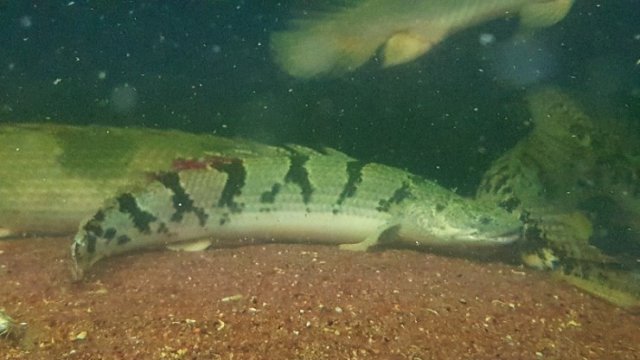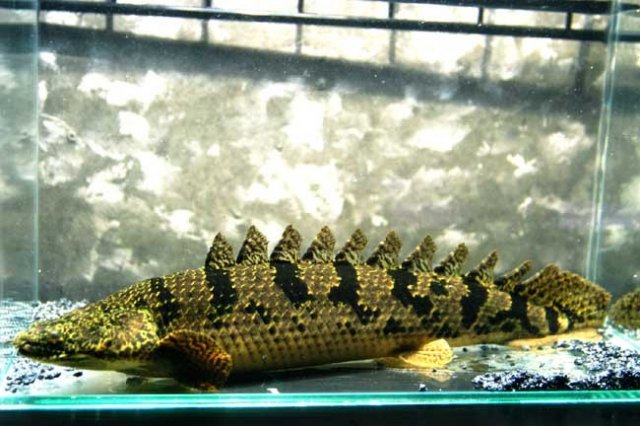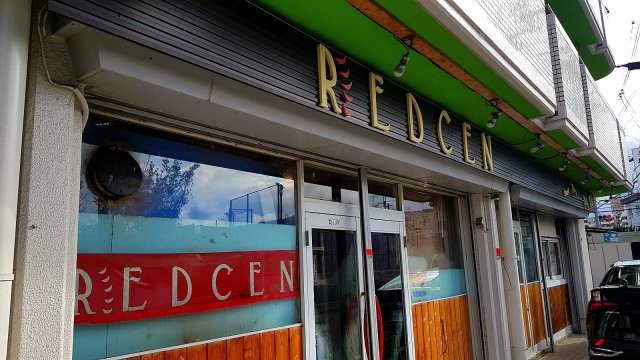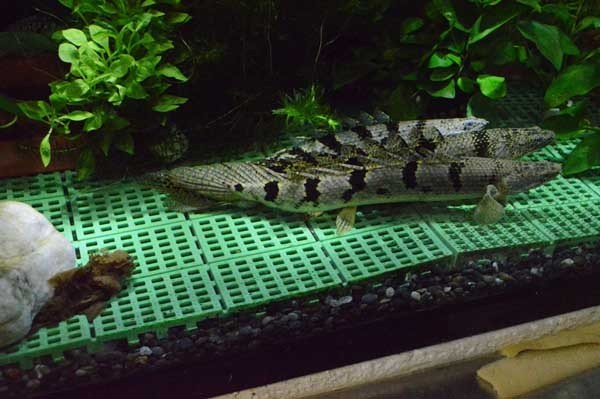
(Polypterus delhezi showing symptom of Aeromonas infactions)
Disease.
Most of all Polypterus have very strong tolarance with many disease so you need to take care about only few that show often.
Poly-worm
This disease is cased by infaction of external parasite called Macrogyrodactylus polypteri.
You can see the actual worms outside of their body, specially on their scale, blushed mucus and scale and they might trying to scach their body to anything.
Because this parasite is too small and transparent, you need to watch very carefully to find it.
Treatment can be done by Praziquantel, i use 100ml of liquid type of praziquantel for 1000L of tank water for 24 hours with 0.3% salt treatment.
You need to be careful for powder-type of praziquantel because it wil not melt to water in normal ways and uneffective if you use it directly not if what you are useing is specially made for water.
I also use Praziquantel to quarantaine for poly-worm by 4mins bath with 4ml of liquid praziquantel for 1L water.
Columnaris disease
Columnaris disease is cased by a Gramn-negative Bacteria named Flavobacterium columnare.
The tail of you fish start getting white and melt when they infected this disease and showing unnatural swimming.
This bacteria staying in the internal organs of fish in normal days and getting very active when fish get stressed and low immune and make infections.
(High daily temperature differences, bad water quality, bad foods also can be a reasons)
This disease is also quite contagious so if one fish show symptoms, it can infect others only with share of water or equipments.
You can cure this with antibiotics can treat Gramn-negative bacteria like Nitrofuran or Oxytetracyclins.
Also this disease can kill your fish in very short days so you need to have right medications before and treat right away when they show symptoms.
Aeromonas disease
Aeromonas disease is cased by a Gramn negative bacteria belongs to genus Aeromonas.
Major symptom is showing reddish and blody belly and do unnatural swimming.
This disease looks similar in early stage but it will not melt the finlets of fish.
This bacteria also staying in internal organs of fish naturally like colmunaris and become active when fish get low immune.
You can use same medications with columnaris for this disease and if they symtoms get bad quickly, you can also consider to use antibiotics injection to cure it.
This disease us less contagious than Columnaris but can be very deadly so you need to be careful when there is high daily temperature differences.
Concautions.
Unlike any other disease i mentioned above, this is not cased by any pathogen.
Major reasons of concaution is smashing their head to wall or tank cover when delhezi get freaked out by something and this is one of the most common reason of death for adult size delhezi.
When the fish get concaution, they will show weird swimming or even fliped over and die in very short time.
Because this is very deadly for your fish you neeed to do right treatment in very shor periode of time.
I recommend to put fish out of tank and contain in shallow water and most importantly, inject Butaphotphan quickly as you can.
Butaphosphan can melt mussel if you inject itself so you need to dilut with other injections like Vitamin doses with 1:9 rate.
(= Butaphosphan : Vitamin)
I usually inject 0.1 ml of mixture for adult size delhezi and 0.05ml for juvenile and keep them in shallow water till they become to able to swim normally.



































